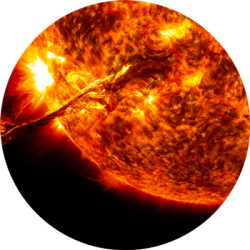An experiment during which the most heat in the Universe, was carried out using the famous Large Hadron Collider. The experiment was carried out by Swiss scientists in 2010, on November 7th.
The goal of the experiment, which led to the record, was to obtain a quark-gluon plasma. This matter filled our Universe in the very first seconds that followed the Big Bang.
To recreate the conditions of the Big Bang, physicists accelerated lead ions to near light speed. The ions began to collide with each other, leading to "miniature" Big Bangs. The nuclei of lead atoms began to melt and turn into a "broth" that consisted of gluons and quarks. So scientists have recreated plasma with the highest temperature that existed in our reality, literally from the beginning of time.

The ability to achieve such results depended on the charge of the ionic particles. The overall particle size used in the experiment was minimal, so the experiment was safe for the planet.
The resulting temperature in artificial conditions reached 10 trillion degrees Celsius. It was two hundred thousand times higher than the indicators that characterize the solar core. The temperature obtained under artificial conditions lasted only a few milliseconds, but scientists received enough information to study them for subsequent years.
Shortly before the experiment with lead, scientists managed to create a record high temperature of 4 trillion degrees Celsius, but the record lasted only two months.
The temperature that existed in the first moments after the Big Bang is called the Planck temperature. It got its name from Max Planck, a physicist from Germany. The first moments immediately after the formation of the Universe as a result of the Big Bang were called the Planck era. It was then that the substance of the young Universe had the highest temperature in its history.
The lowest temperature was also created as a result of a scientific experiment. A group of researchers from the Finnish city of Helsinki in 2000 received a temperature of 0.1 nK in an experiment with the metal "rhodium". Three years later, a group of physicists from Massachusetts obtained the second largest result - super-cold sodium gas.
In science, there is the concept of absolute zero. This is the coldest temperature. The absolute zero is recognized as -273.15 ° Celsius. It is this indicator that is recognized as the starting point of the Kelvin scale. It is believed that absolute zero temperatures cannot be reached.
In conditions close to this figure, substances acquire special properties. These are superconductivity, superfluidity (when a substance can pass without friction through narrow slits) and Bose-Einstein condensate. The latter is characterized by the manifestation of quantum effects at the macroscopic level.
Research into record low temperature indicators is of great importance for science and the entire civilization. They are studying the effect of superconductivity of natural elements, which can open the doors of new achievements for science.
The lowest recorded temperature in a non-tampered environment is in the Boomerang Nebula. There, molecules of cooled gas are thrown out with great speed, and thanks to this, an indicator of -272 ° Celsius is reached.
In the Boomerang Nebula is a white dwarf that was once a star similar to our Sun, and then a red giant. Now a protoplanetary nebula with a temperature record has arisen around the dying star.
The lowest temperature indicator in the borders of our Solar system refers to a distant planet. On Triton (satellite of Neptune), an indicator of -235 ° C was recorded. Liquid nitrogen settles like frost or snow on the surface of the satellite planet.

Some temperature records:
- The coldest temperature on our planet - minus 89.2 ° Celsius, was documented at Vostok station on the continent of Antarctica in 1983.
- Ice dome A deep in Antarctica (1,200 kilometers from the coast) is recognized as the coldest place on the third planet from the Sun. His average annual temperature is -58.3 ° C.
- The hottest temperature on our planet was recorded in 1913 in Death Valley (California, USA). On a fine day, July 10, it was 56.7 ° C.
- The highest average annual temperature on Earth is documented in the Dallol area (Ethiopia). It is 34.4C °.
Although the highest temperature was reached within the scientific experiment, it is assumed that this is not the limit at all. Further research will help to recreate conditions that would correspond to the time after the Big Bang, and to improve knowledge about the structure and history of the universe.
The most low temperature in the world, which is also called “ absolute zero”Is zero degrees Kelvin or -273.15 degrees Celsius or 459.67 degrees Fahrenheit. It is impossible to imagine that the lowest air temperature is more than minus 100 degrees. A few facts: the lowest temperature on the Moon reaches -240 degrees Celsius, the lowest temperature in humans reached 14.2 degrees Celsius. If you take into account science fiction films or works, then you can find the freezing technique. During this appointment Living being it cools down so much that it can survive for several millennia without aging or deteriorating. But is this so in practice?
From a theoretical point of view, this is possible if the substance lacks internal energy, in other words, the movement of the smallest particles in the substance must be completely stopped. When the substance cools, these particles slow down. It should be assumed that there is a cooling limit during which each particle oscillation can be stopped or, in other words, frozen.

In fact, there is this limit, but this is only in theory. This value was named “Absolute Zero”. Absolute zero is the lowest temperature of matter in the Universe. In laboratories, you can reach any small temperature values, but absolute zero will not be reached, because this value contradicts all the laws of physics and thermodynamics in particular.
Physicists from the United States Eric Cornell and Karl Wieman have approached the lowest temperature in nature. In 1995, during the cooling of rubidium atoms, physicists were able to reach temperatures less than 1/170 billion of a degree above absolute zero (5.9-10-12). Where is the lowest temperature found on our Earth now? Under natural conditions, the lowest temperature in the world can be found only in outer space. There the temperature reaches -270.5 Celsius. This is due to the relic radiation that pierces our Universe. This temperature is approximately 2.7 Kelvin.


Where has the lowest temperature recorded on Earth? The lowest temperature has now been recorded in Antarctica. The lowest air temperature is -89.2 degrees Celsius. This record was achieved in 1983. After that, the lowest temperature on Earth could not break this record. But 30 years later, in 2013, scientists were able to set another record. The lowest temperature on the planet has reached -93.2 degrees Celsius. The area with the lowest temperature in the world is located in the mountains of Antarctica between the two peaks of Fuji and Argus. All measurements and studies were carried out by scientists using a satellite. But this lowest recorded temperature was not included in the Guinness Book of Records. And all because the measurements were made by a non-contact method from a satellite, and not by a contact thermometer.
About the lowest temperature in Celsius in the cities of Russia. The coldest temperature in Percy was recorded in 1978 at -47.1 degrees. Norilsk is one of the northern cities of Russia and the lowest temperature in Norilsk can drop -60 degrees Celsius. The lowest temperature in Surgut reaches -40 degrees. But the lowest temperature in Sochi was recorded in 1899, it is -4 degrees. The lowest temperature in Crimea reached -36.8 degrees. This temperature was recorded in 1940. The lowest temperature in Thailand can drop to +20 degrees and for local residents this is considered "severe frost". As it sounds not paradoxical, but in 1935, in February, the lowest temperature in Africa was recorded. The temperature dropped to -23.9 degrees. Frosty Yakutia, the lowest temperature of which reached -77.8 degrees Celsius, is considered the coldest place in Russia.
With the onset of winter cold weather, our lifestyle changes dramatically, since the human body is more comfortable being warm. We dress, warm our homes, protect what can be damaged by frost. Motorists, as usual, are concerned about where to buy an anti-freeze. Unless, of course, you are a resident of Urengoy or another northern city, you may not have experienced a very searing frost. In the 19th century, for each earthly continent, its own records of low temperatures were recorded. So in Antarctica the limit was -89C, in Asia -68C, in North America- 66C, in Europe -58C, in South America-39C, in Africa -24C, in Australia -23C. In 1963, a temperature of -143C was recorded in the atmosphere over Sweden. This is the lowest temperature recorded in the Earth's atmosphere to date.
Absolute zero
Any substance consists of atoms and has its own internal energy. Absolute zero or a temperature of -273C for a substance occurs when it is completely devoid of any energy.
Where is the lowest temperature in the universe? At night, the temperature of the moon's surface can drop to -227C, and the cosmic vacuum is a void with a temperature of -265C. But the lowest temperature is not in space, but, oddly enough, on Earth. In laboratory conditions on Earth, it is theoretically possible to reach a temperature of -273.15C. One of the first discoverers of this event were scientists of the first half of the twentieth century, who studied the properties of mercury at ultra-low temperatures. Cooled to -262C mercury reduced its resistance to current to almost zero, thereby becoming a superconductor. The cooled materials also had superfluidity and the ability to seep through solid matter.
Scientists at the University of Massachusetts experimented with sodium atoms, trying to keep them in the same quantum state using a magnetic field. By this, they almost approached absolute zero temperature. Such a Bose-Einstein condensate, named after the scientists who predicted the event, has extraordinary properties. As you know, the speed of a light beam in a vacuum is 300,000 km / s, and in the created condensate the speed of light slows down until it stops completely. This gives prerequisites to "collect" light photons and convert their electric current.
From the above, we can conclude that even the most severe cold can be beneficial, and not just inconvenience in the winter road, when only non-freezing can be saved in bulk, which is much more profitable.
Every decent atom loves warmth. He loves so much that when he heats up, he begins to vibrate vigorously, vibrate, move in different directions. The more a substance heats up, the faster its atoms move and the higher the temperature. Our life takes place in a very narrow temperature range. If the thermometer reads more than 42 degrees, then in the absence of an antipyretic person, the person will die pretty quickly. The change average temperature the near-earth atmosphere is only half a degree fraught with droughts, floods, hurricanes. At the same time, the temperatures in the Universe vary over an unusually wide range, and the highest of them simply boggle the imagination.
Highest possible
Where At the birth of the universe.
Meaning 1.416 808 (33) × 10 32 degrees Kelvin (that is, one hundred million times more than a trillion trillion).
Circumstances It was from zero to 10 -43 seconds in the development of our universe. That time is called the Planck era and it still defies description by the existing methods of mathematics and physics. It is assumed that the quantum field, which constituted the whole world at that moment, was so heated.
The universe was then practically a point, 10 times 35 times less than a meter. And it had a record density (of course, drive the entire space into a grain of sand!), Energy, and also the highest of the temperatures that can be described. With everything that is hot, physics can no longer cope due to the absence of the theory of quantum gravity - a concept that combines the postulates of quantum mechanics and relativistic physics. Above this temperature, four interactions - gravitational, electromagnetic, weak and strong - merge into one, and even Einstein at one time failed in creating an adequate theory describing this phenomenon.

The highest in our time
Where The center of a fresh neutron star.
how many 1,000,000,000,000 degrees Kelvin.
Circumstances Even the best New Year's fireworks are unlikely to be compared to those that the Universe sometimes arranges. Some supernova explosions exceed many galaxies in luminosity. After the universal fireworks, either a neutron star or a black hole remains from the star. In the first case, the temperature in its core can reach a trillion degrees (10 12 K), however, due to the intense emission of neutrinos in seconds, it drops to 100 billion degrees, and after a few years does not exceed "only" a million. Interestingly, even black holes can heat up to tens of millions of degrees, if there is a star nearby, from which it is possible to pump out plasma. Such a plasma, spinning into a disk around the hole, is heated to colossal temperatures due to friction.

Highest in the solar system
Where Center and crown of the Sun.
how many 15,000,000 degrees Kelvin at the center of the Sun and up to 20,000,000 in some parts of the corona.
Circumstances The surface of our star is not so much a record holder - some 6000 kelvin, as well as in the center of the Earth. But the core heats up to 15 million, but even it is surpassed by the solar corona above the surface of the star. It consists of streams of gas, giant prominences - energy emissions millions of kilometers in size. On average, the corona heats up to 1-2 million degrees, but in some emissions the temperature can be higher than in the core.
Among the planets, the highest temperatures should be sought on Mercury and Venus. Mercury is the leader in temperature extremes: the side facing the Sun heats up to 473 ° С, and in the shade there can be "frost" up to 193 ° С. Venus, hot due to the greenhouse effect, is slightly inferior to its neighbor - 464 ° C, but the climate there is more even.

Highest man-made
Where The Large Hadron Collider.
how many≈10,000,000,000,000 degrees Kelvin.
Circumstances The heroes of the fantasy TV series Lexx, aliens, watch the explosion of the Earth after the launch of the LHC. But they warned! .. However, the Earth does not think to explode yet, but this collider gave out the highest recorded temperature in the Universe, and this is the result of purposeful activity of people. In 2010, scientists collided two lead ions, accelerating them to near-light speeds. Such experiments make it possible to better understand the early Universe, because it was to such temperatures that it warmed up in a few seconds after the start of expansion.
If we talk about the benefits for National economy, then to start a thermonuclear reaction, the dream of all power engineers in the world, the plasma needs to be heated only to 100 million degrees. But this temperature must be maintained long enough, so that the collider is not an assistant here.

Tallest on earth
how many 56.7 ° Celsius.
Circumstances Until 2012, the hottest spot was considered the town of Al-Aziziya in Libya, where in 1922 the temperature was recorded in excess of 58 degrees (naturally, in the shade). But the World Meteorological Organization issued a press release in which the correctness of the measurements and the qualifications of the Libyan meteorologist were questioned. In general, despite the general warming of the climate and the renewal of local records (for example, in 2010 the temperature maximum was recorded in Russia - 45.4 ° C at the meteorological station in Kalmykia), the Californian ranch Furnis Creek remains the leader. As for the weather outside settlements, here the primacy belongs to the Deshte-Lut saline desert in Iran, according to satellite data, warming up to 70.7 ° C.




